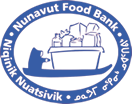“Data allows us to see things like the percentage of our clients who come … without fail”
Iqaluit’s Niqinik Nuatsivik Nunavut Food Bank recently started using a new registration system to better serve its clients.
As a result, the food bank is able to know clients by name and better understand their needs, chair Bruce McRae told the organization’s annual general meeting on Monday.
“Our interactions with them now involve us saying things like, ‘How’s it going? Are there still three kids in your home?’ So the number of adults and the number of children that live in a household is what determines how big a family assistance package they’ll get,” he said.
The client registration system was developed in the summer of 2018, but McRae said the food bank became “really serious” about cataloguing each client in early 2019.
Because the food bank provides food based on things like family size and need, the data will allow its operators to see these details to improve the structure of their services.
“Data allows us to see things like the percentage of our clients who come to every distribution without fail,” McRae said. “That would be an indicator or someone who has more need, so maybe we want to supplement their need or address programming to that population.”
McRae said in accordance with the privacy law, the food bank seeks client consent to participate in registration. No personal data is shared beyond the few people who need access to it to manage the food bank’s operations, he added. If data is analyzed, no personal identifying information is used.
The system was put in place ahead of the food bank’s new voucher program. That pilot project was made possible by a $15,000 grant from Qikiqtani Inuit Association’s cultural activities program, McRae said.
The voucher program, which has since ended, improved access to country food by providing clients with vouchers for bullets and gas to share with hunters.
“We knew we needed a registration system because vouchers were something where a client had to come in at least once,” he said.
The food bank distributed 492 vouchers worth up to $60 each over seven distributions, according to their 2019 annual report. Clients were very satisfied with the project, McRae said.
McRae said he hopes the food bank will continue the voucher program, but further analysis of the project is still ongoing.
In terms of stock, Niqinik Nuatsivik purchased much of its sealift last year from the Wholesale Club at standard southern wholesale prices. Their total sealift in 2018 was 33 pallets in three sea cans, costing approximately $90,000 in food costs and $25,000 in shipping.
The food bank distributes to roughly 85 households every two weeks, according to the report.
The majority of funding for the 2019-2019 fiscal year came from grants, including money from the Government of Canada and the voucher grant from QIA. The food bank received over $140,000 in donations and grants, including support from Food Bank Canada in the last fiscal year.
A motion was passed at the end of the meeting to streamline Niqinik Nuatsivik’s operations with Iqaluit’s Qajuqturvik Food Centre.
Because both organizations operate out of the same facility and both work toward the goal of alleviating food insecurity and increasing food sovereignty in the region, the AGM agreed to consult with QFC over the next year on ways the two groups can work more collaboratively.

